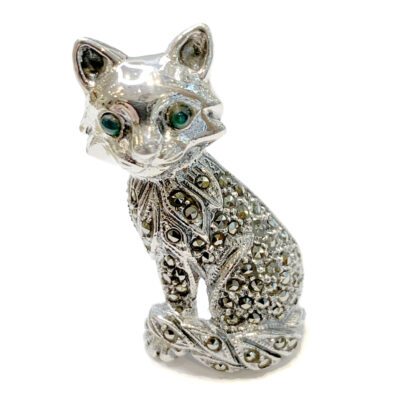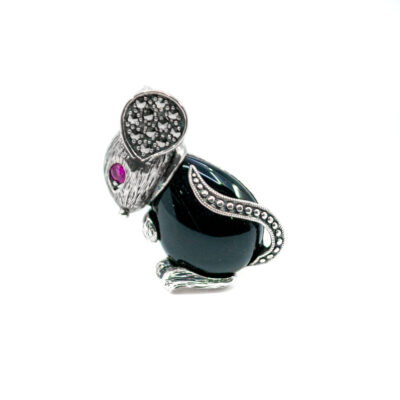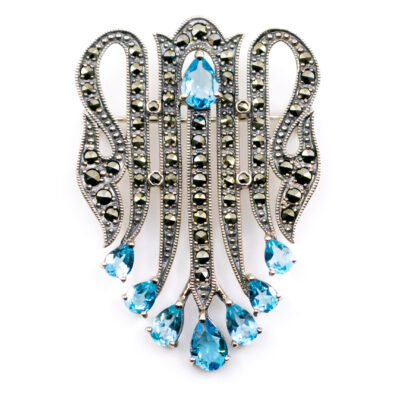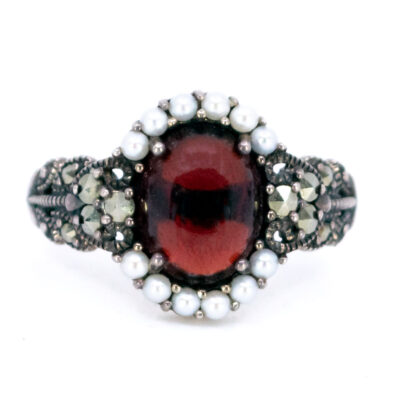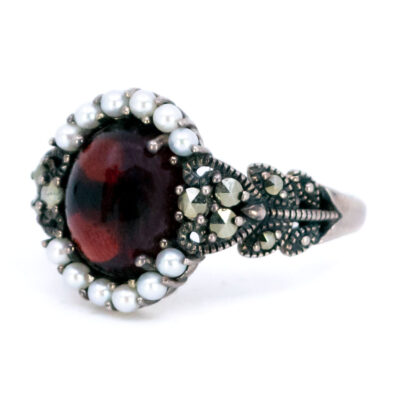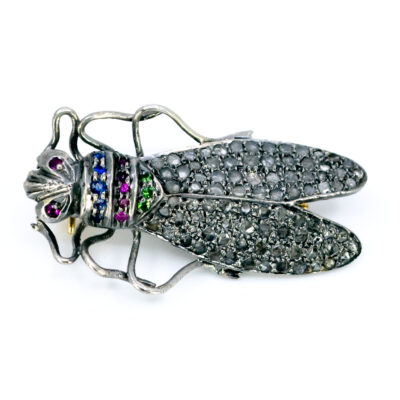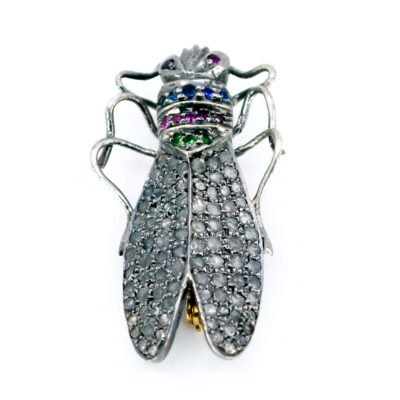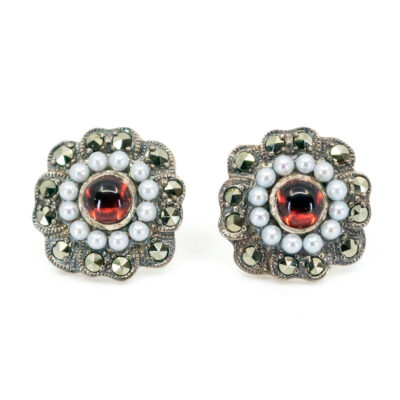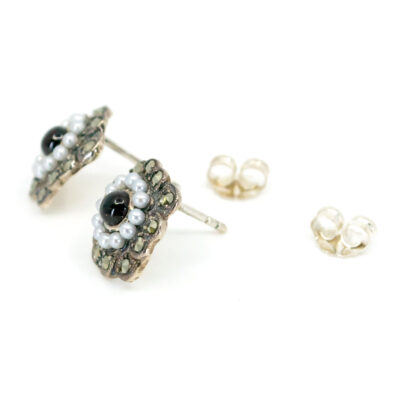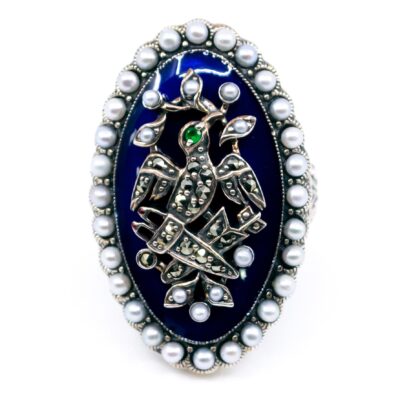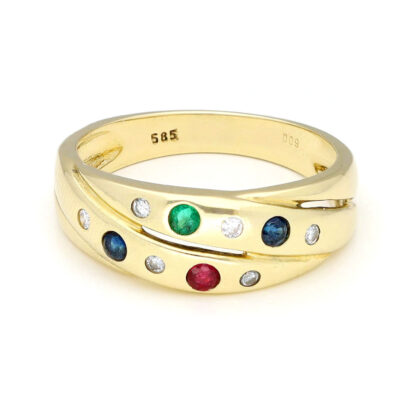This elegant Victorian-style brooch features a floral design and is made of silver. It is adorned with round garnets weighing approximately 2.00 carats, pearls, agates, and marcasites (pyrite). The combination of these beautiful gemstones creates a stunning piece of jewelry.
Videos
This elegant Victorian-style brooch features a floral design and is made of silver. It is adorned with round garnets weighing approximately 2.00 carats, pearls, agates, and marcasites (pyrite). The combination of these beautiful gemstones creates a stunning piece of jewelry.
Details: ±2.00ct Garnets, Pearls, Agates, Marcasites (pyrite), 925′ Silver, Brooch
Dimensions: 3.3 x 3.8 cm.
Weight in grams: 14.6.
Condition: New.
| Design Era | |
|---|---|
| Design & Historical Context | The Victorian Era spanned Queen Victoria's rule of England from 1837 until 1901. During this time, a middle class began to emerge, sparking a demand for jewelry in the mass market, jewelry trends often reflected the tone of current events. The era is usually divided into several subsections: the Romantic Period from 1837 to 1861, the Grand Period from 1861 to 1880, and the Aesthetic Period from 1880 to 1901. During the Romantic Period jewelry also featured nature-inspired designs, similar to jewelry of the Georgian era. Frequently, these designs were delicately and intricately etched into gold. Lockets and brooches were popular in daytime jewelry during the early Victorian era, whereas colored gemstones and diamonds were worn during the evening. During the Grand Period jewelry , because the Grand or Mid-Victorian era corresponded with the death of Queen Victoria's husband, many jewelry pieces have solemn, somber designs. Known as mourning jewelry, the pieces feature heavy, dark stones. Jet, onyx, amethyst, and garnet are frequently found in jewelry from this period. Compared to previous periods, Mid-Victorian-era jewelry features highly creative, colorful designs using shells, mosaics and gemstones. During the Aesthetic period, jewelers used diamonds and feminine, bright gemstones such as sapphire, peridot, and spinel. Star and crescent designs as well as elaborate hat pins were also popular. Some scholars believe the aesthetic era began sooner, in 1875, and ended as early as 1890. |
| Key Materials | |
| Materials & Craftsmanship | Garnet: The Stone of Passion and Protection Garnet, renowned for its deep red hue, is a gemstone that symbolizes passion, energy, and protection. Though commonly associated with its rich red color, garnet actually comes in a variety of shades, including green, orange, and even rare blue, making it a versatile and intriguing gemstone. Garnet has a long history of use, dating back to ancient Egypt, where it was worn by pharaohs as a symbol of life and power. In Roman times, garnets were often set into signet rings used to stamp wax seals on important documents. The stone was also believed to offer protection to travelers and warriors, warding off harm and ensuring safe journeys. In jewelry, garnet’s durability, with a Mohs hardness of 6.5 to 7.5, and its striking color make it a popular choice for rings, necklaces, and earrings. Its ability to capture and reflect light with a warm, fiery glow adds a touch of drama and sophistication to any piece. Garnet is more than just a gemstone; it is a symbol of enduring passion and strength. Its vibrant energy and historical significance make it a timeless and powerful choice for jewelry that stands out and tells a story. Pearl: The Gem of Elegance and Purity Pearls, with their natural luster and timeless beauty, are one of the most revered gemstones in the world. Unlike other gems, pearls are organic, formed within the soft tissue of mollusks like oysters and mussels. Their formation process results in a smooth, round gem with a soft, iridescent glow, often referred to as the "pearl essence." Historically, pearls have been a symbol of purity, wisdom, and wealth. In ancient Rome, they were considered the ultimate status symbol, while in ancient China, pearls were believed to protect against fire and dragons. During the Renaissance, pearls were so highly valued that they were reserved for royalty and nobility, symbolizing perfection and integrity. In modern jewelry, pearls are cherished for their classic elegance and versatility. They are commonly found in a range of colors, from the traditional white and cream to rare black, pink, and golden hues. Pearls are often strung into necklaces, set into earrings, or used as delicate accents in rings and bracelets. Their softness, with a Mohs hardness of 2.5 to 4.5, requires gentle care, but their beauty and sophistication are unmatched. Pearls are more than just a gem; they are a symbol of grace, purity, and timeless style. Their natural origins and understated elegance make them a beloved choice for jewelry that exudes refinement and sophistication. Agate: The Stone of Stability and Grounding Agate is a gemstone celebrated for its rich patterns and soothing colors, making it a symbol of stability, strength, and grounding. This variety of chalcedony is known for its wide range of colors and distinctive banded patterns, which are formed by layers of mineral deposits over time, creating a unique and mesmerizing effect. Historically, agate has been valued for its protective and healing properties. Ancient civilizations, including the Greeks and Egyptians, believed agate could ward off evil and bring balance to the wearer. It was often used in amulets, seals, and talismans for its supposed ability to calm the mind, protect against danger, and promote inner stability. In modern jewelry, agate is prized for its versatility and natural beauty. Its durability, with a Mohs hardness of 6.5 to 7, makes it suitable for a wide range of jewelry pieces, from rings and necklaces to bracelets and earrings. Agate is often cut into cabochons or beads to showcase its intricate patterns and is commonly used in both contemporary and vintage-inspired designs. Agate is more than just a gemstone; it is a symbol of grounding and stability, offering a connection to the earth and a sense of balance. Its natural beauty and variety of colors make it a versatile and meaningful choice for jewelry that is both aesthetically pleasing and deeply symbolic. Marcasite (pyrite): The Gem of Timeless Elegance and Vintage Charm Marcasite, often mistakenly referred to as pyrite, is a gemstone that has captivated jewelry enthusiasts for centuries with its metallic luster and vintage appeal. Although marcasite is technically a form of pyrite, true marcasite jewelry is made from pyrite crystals that are cut and polished to create a shimmering, antique look. Historically, marcasite has been admired for its mysterious, reflective surface, often used in intricate, filigree designs during the Victorian and Art Deco periods. In the 18th and 19th centuries, it became particularly popular in Europe as a more affordable alternative to diamonds, lending an air of elegance and sophistication to brooches, rings, and other accessories. In modern jewelry, marcasite is prized for its ability to add a touch of vintage charm and drama to any piece. Its metallic, gunmetal-gray hue pairs beautifully with silver settings, and its natural sparkle makes it a standout in both understated and ornate designs. Marcasite is commonly seen in rings, earrings, pendants, and brooches, often set in sterling silver to enhance its classic, antique look. Marcasite is more than just a gemstone; it is a symbol of timeless elegance and enduring style. Its historical significance and unique, reflective quality make it a cherished choice for jewelry that exudes both character and sophistication, perfect for those who appreciate the charm of vintage-inspired designs. Silver: The Metal of Elegance and Versatility Silver, known for its bright, reflective luster, is one of the most beloved and widely used precious metals in the world. This versatile metal has been cherished for thousands of years, not only for its beauty but also for its malleability, making it ideal for crafting intricate and delicate jewelry designs. Historically, silver has been associated with the moon and considered a symbol of purity, clarity, and protection. Ancient civilizations, from the Egyptians to the Greeks and Romans, valued silver for its beauty and used it to create coins, jewelry, and religious artifacts. In many cultures, silver is also believed to have healing properties, often used in amulets and talismans to ward off negative energy. In modern jewelry, silver is prized for its affordability, versatility, and timeless appeal. Sterling silver, an alloy of 92.5% pure silver and 7.5% other metals (usually copper), is the standard used in high-quality jewelry. Its durability and bright, reflective surface make it an excellent choice for a wide range of designs, from minimalist pieces to ornate creations. Silver can be polished to a high shine or given a matte, oxidized, or antiqued finish to suit various styles. Silver is more than just a metal; it is a symbol of elegance, flexibility, and understated luxury. Its enduring popularity and wide-ranging applications make it a staple in jewelry that can complement any look, from casual to formal, with timeless grace. |
| Dimensions | 3.3 x 3.8 cm |
| Gender | |
| Weight (in grams) | 14.6 |
| Condition |
By following these tips, you can enjoy your precious jewelry for many years to come.
Related Products
-
Agate Marcasite (Pyrite) Silver Cat Brooch 14273-1572
€ 165,00 VAT incl. (where applicable) -
Agate Silver “Garter” Brooch 16245-2519
€ 695,00 VAT incl. (where applicable) -
Marcasite (Pyrite) Onyx Ruby Silver “Mouse” Brooch 16227-2515
€ 195,00 VAT incl. (where applicable) -
Topaz Marcasite (Pyrite) Silver Deco Brooch 13118-1175
€ 295,00 VAT incl. (where applicable) -
Diamond 14k Silver Victorian Brooch 14923-8423
€ 2.695,00 VAT incl. (where applicable) -
Garnet Marcasite (Pyrite) Pearl Silver Ring 9670-6411
€ 265,00 VAT incl. (where applicable) -
Diamond Emerald Ruby Sapphire 14k Silver Insect Brooch 12262-7393
€ 1.295,00 VAT incl. (where applicable) -
Garnet Marcasite (Pyrite) Pearl Silver Floral Cluster Stud Earrings 16833-2732
€ 175,00 VAT incl. (where applicable)
- Home
- Collection
- Fine Jewelry
- Silver Jewelry
- Silverware
- Boxes
- Candlesticks
- Salt and pepper shakers
- Miniatures
- Salt cellars
- Spoon Set
- Condiments
- Frames
- Napkin Ring
- Spoon
- Oddities
- Cups
- Vases
- Cutlery
- Serving Spoon And Cake Server
- Candlesticks
- Baskets
- Hanukkiah
- Spice Tower
- Yad
- Tea Set
- Sugar Castor
- Napkin Rings
- Wine Bottle Coaster
- Wine Stopper
- Tea Pot
- Jugs
- Rattles
- Hip Flask
- Miscellaneous
- Rings 💍
- About
- Contact
- No products in the cart.





